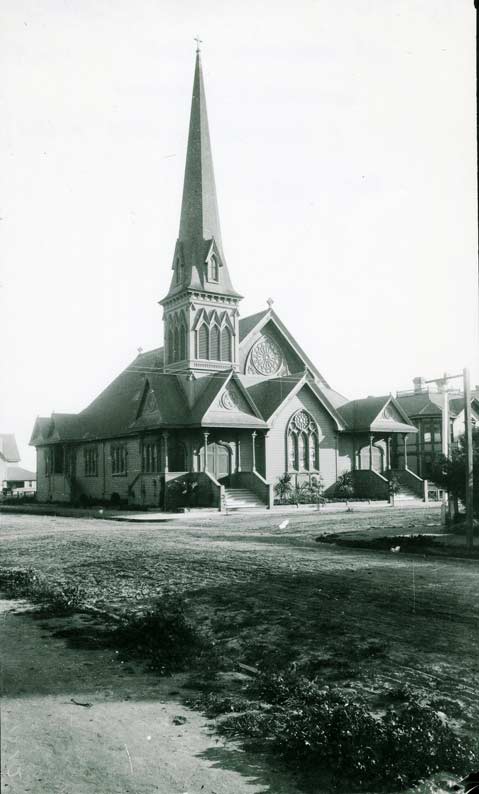One of Santa Barbara’s most distinctive buildings is the beautiful stone edifice at 1500 State Street, the home of Trinity Episcopal Church. Founded in 1866, the Episcopal congregation was the second Protestant denomination to hold regular services in Santa Barbara, after the Congregationalists.

There was no call for Protestant churches in Santa Barbara during the Spanish and Mexican eras; the population was united in the Roman Catholic faith. The few Americans who did settle here invariably converted to Catholicism if they wished to marry or own land. In the 1850s, the number of Protestant newcomers slowly grew in the aftermath of the Gold Rush and California statehood. The first Protestant sermon preached in Santa Barbara appears to have been by the Reverend Adam Bland, a Methodist circuit rider, in 1854.
The first Episcopal service took place on December 16, 1866, in the county courthouse, the former John Kays adobe, located in the same block where the courthouse is today. The name “Trinity” was bestowed upon the church the following March, reportedly at the suggestion of a parishioner who had attended an Episcopal church of the same name in New York City. The early membership roll of the church contained many familiar names, such as W.W. Hollister, Charles Fernald, Russel Heath of Carpinteria, and ship captain Martin Kimberly, to name just a few.
It soon became apparent that new quarters were needed. In September 1868, the parish held a fair to raise money to build a church in the first block of East Gutierrez Street on a lot donated by parishioner Samuel Brinkerhoff. The highlight of the fair was undoubtedly the serving of ice cream, a food heretofore unknown in the city. A loan fleshed out the building fund, and although the church was not quite finished, the first service was held there on Christmas Day 1868. It was the first Protestant church building in Santa Barbara.
Additional construction occurred in the early 1870s, but controversy arose. John Cornell, appointed rector in September 1873, did not approve of raising money by holding fairs and throwing parties. When it became apparent the congregation felt otherwise, he resigned after only five months in office.
The arrival of the Southern Pacific to Santa Barbara in 1887 marked the beginning of a new era for Trinity. The tracks went down the middle of Gutierrez, right past the church doors, and the resulting noise, dust, and smoke convinced parishioners to pull up stakes. The building was sold, and a new redwood church with a 120-foot steeple arose where the public library sits today at Anacapa and Anapamu streets. The congregation continued to grow, numbering more than 200 by the early 1900s.
Misfortune struck before dawn on December 20, 1903, when the church burned to the ground. Services were held later that day at the nearby Elk’s Hall. Funding for a new church moved forward slowly; not until 1912 did construction begin. In the interim, services took place in the church’s Sunday School building. Two Pasadena architects designed a magnificent native sandstone structure at 1500 State Street. The building cost $54,000, and the debt was not paid off until 1919.
The earthquake of June 29, 1925, virtually demolished the stone church. Once more, the congregation dedicated itself to rebuilding and renewal. The result was today’s Trinity Church, a triumph of the spirit and faith.



